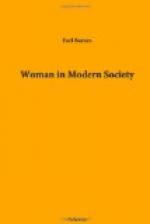In 1848, the women of the country began to organize. Mrs. Elizabeth Cady Stanton, Lucretia Mott and Martha C. Wright called together at Seneca Falls, New York, the first convention in America to further equal suffrage. No permanent organization was founded, but in 1850 a convention was held in Salem, Massachusetts, and in 1852 a Woman’s Rights Convention was called in Syracuse, New York, with delegates present from eight States and Canada. Miss Susan B. Anthony had meantime joined the movement; and from this time on conventions and appeals became common.
The Civil War distracted attention from all social and political issues but one. The Equal Rights Association turned its attention mainly to the rights of negroes; and in 1869 the National Woman’s Suffrage Association was organized to work exclusively for woman’s rights. Backed by such women as Susan B. Anthony, Lucy Stone and Julia Ward Howe, and aided by men like Henry Ward Beecher, the association became a national power. In 1890, the two organizations were united under the name of The National American Woman’s Suffrage Association. This organization still leads the movement in America.[45]
[45] The History of Woman Suffrage, by ELIZABETH CADY STANTON, SUSAN B. ANTHONY, and IDA HUSTED HARPER, 4 vols. Rochester, N.Y.
In 1902, an international meeting was called in Washington; and in 1904 the International Suffrage Alliance was formed in Berlin with Mrs. Carrie Chapman Catt as president. Thirteen nations are now affiliated with the Alliance; and the women of the world are highly organized to further equal suffrage.
Two generations of women have given themselves to this movement, and a third still faces it. To the first group belong those leaders we have already named: Emma Willard, Elizabeth Cady Stanton, Julia Ward Howe, Susan B. Anthony and their associates. It was their problem to secure woman’s control of her own body and property, some share in the direction of her children, and some opportunity to train her own mind and earn an independent living. These women bore the heat and burden of a conflict in which all the blind prejudices of a fixed regime were strongly massed, presenting few promising points of attack. It is small wonder that some of these leaders gained a reputation for being hard, dogmatic, aggressive, and sometimes careless of popular sensibilities. The first generation of reformers in any field must be made of stern stuff; and their beneficiaries are apt to forget the conditions that justified means no longer necessary.
The lives of these women could not be expected to fully illustrate the type of life they hoped to see their sisters living when opportunity was finally won. Only women who participated in this struggle could fully appreciate the splendid devotion of these lives to the service of a group many of whom, being personally comfortable, were insensible to the needs of less fortunate women; and were sometimes even willing




